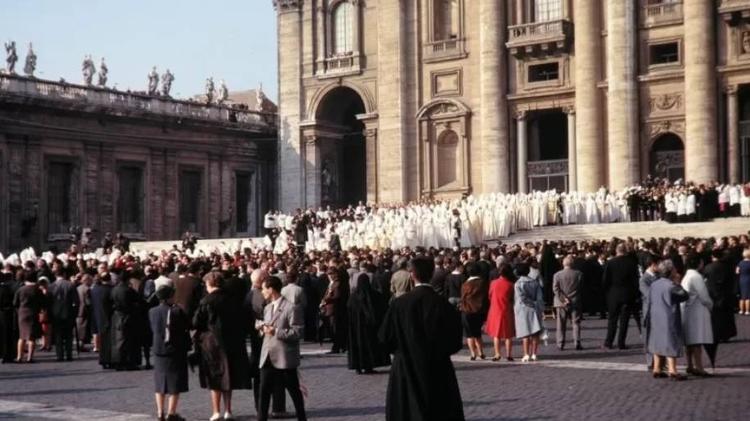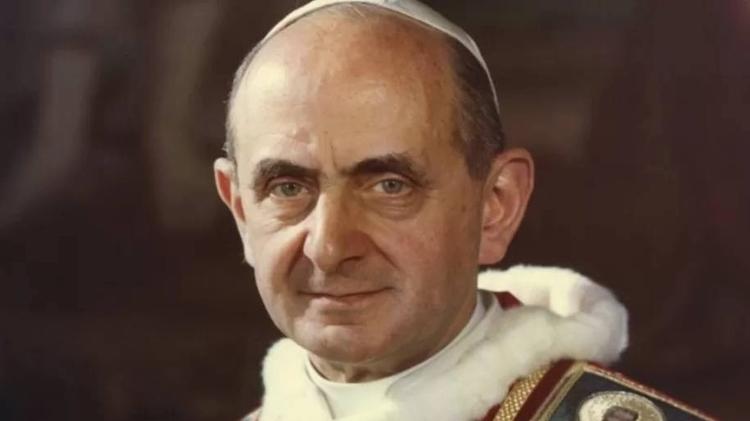Older priests who practiced Catholicism before and after the Second Vatican Council used to say this before people attended mass. Then they started to participate in it. From the point of view of the Catholics attending, it is a fact that illustrates the extent of this meeting of the Catholic Church summit, which took place from October 11, 1962 to December 8, 1965.
Until then, rites were celebrated in Latin with the priest’s back to the faithful. But from then on, the rituals were in the vernacular, the priest faced the public in this state, as if they were all around the same table.
However, this was just one of the changes brought about by the meeting, which aimed to significantly change the mentality of the millennial religious institution.
“By promoting on-wall and off-the-wall dialogue, the council meant the transition of the then-medieval Catholic Church into modernity,” says theologian, historian, and philosopher Gerson Leite de Moraes, a professor at Mackenzie Presbyterian University.
For philosopher and theologian Fernando Altemeyer Junior, a professor at the Pontifical Catholic University of São Paulo (PUC-SP), the meeting was important “because it opened the Church to dialogue with the world and separation from the prisons in which it was locked up.”
“Vatican II was guided by the word ‘update’. To be updated in the face of the challenges of the world, with changes, with the advancement of science and technology, with changing moral questions and social questions that demand answers, in an environment of warfare. Cold”, deputy director of the Lay Center in Rome It highlights the Vaticanist Filipe Domingues. He points out that it has been “a long time” since the church has undergone a radical reform and that the council has had an opportunity to review paradigms.
It was nothing simple, not overnight, of course. In the history of the Church, the meetings that the Pope called to discuss the future of the organization are called councils based on the paradigms of faith, tradition and doctrine. They assemble the hierarchical leadership of the church and go through intense debate.
loyal
Vatican II took place in four sessions from October 1962 to December 1965. Two popes, John 23 (1881-1963) convening the synod, and his successor Paul 6 (1897-1978), 129 generals, 12 patriarchs, two patriarchal priests, 122 cardinals, 398 archbishops, 1,980 bishops, 91 bishops and other religious positions.
Among all the participants of the meeting, there are only six living beings, no Brazilians. “Brazil sent 221 bishops and bishops to the meeting, in addition to 9 experts and one layperson,” says Altemeyer Junior.
In total, the council resulted in the issuance of four constitutions, nine decrees and three declarations.
In general, it is possible to define the effect of the event in four axes.
“New liturgy in local languages, the resumption of the word of God as the center of the Catholic faith, action in favor of the transformation of the world, and the new awareness of the Church as a means of dialogue with the realities of the world and other religions,” explains Altemeyer.
In other words, post-Council Catholicism became closer to the faithful, deeper in the Bible, closer to the poor, and more open to other religious manifestations.
“It’s as if the Catholic Church is reconciling with modernity,” says Moraes. “We can talk about the renewal, the revival of Catholicism after Vatican II.”
“How long did it take for that to happen? It took some time. But we must not forget that the Catholic Church is a transatlantic: it is very difficult to reverse this, very difficult to maneuver,” adds the theologian.
Option for the poor
For three years, the Council Fathers reaffirmed that the Church should be with the poor. “The Church reaffirmed the preferential option for the poorest, and this had a tremendous resonance in liberation theology, for example, in Latin American theology,” Moraes says.
This became even more symbolic in a document called the Pact of the Catacombs, which is officially the Pact of the Servant and Poor Church, drawn up and signed by 42 participants on the council.
The pact got its name because it was signed at a meeting in the catacombs of Santa Domitila in Rome. Later, more than 500 religious people became the signatories of the document.
Among the points of the text are the commitment to give “everything necessary for the apostolic and pastoral service of industrious and economically weak and underdeveloped individuals and groups”, the rejection of privileges and titles, and the “opportunity to put everything to others.” We work to get those responsible for our government and public services to decide and enforce laws.”
“As we truly enter modernity, the Catholic Church offers an option for the poor to fight structures that create social injustice,” Moraes analyzes.
With 13 points, the text was presented on November 16, 1965, with the participation of five Brazilians: João Mota e Albuquerque (1909-1984), then Archbishop of Vitória; Francisco de Mesquita Filho (1924-2006), bishop of Afogados de Ingazeira; José Castro Pinto (1914-2007), co-bishop of Rio de Janeiro; Henrique Golland Trindade (1897-1974), Bishop of Botucatu; and then Antônio Fragoso (1920-2006), bishop of Crateús.
One of the main advisors to the agreement was Archbishop Helder Câmara (1909-1999), one of the founders of the Brazilian National Conference of Bishops (CNBB) and already known as a human rights defender. According to Altemeyer’s research, Câmara did not attend the event as he had to attend a council-related meeting at the Vatican summit that same day.
society and ecumenism
Another relevant point of the council was the improvement of communication with believers. Not only because the masses are no longer in Latin and the priest is on his back, but also because the liturgy has begun to involve a more active participation of the congregation.
“And with greater participation in church buildings, secular people began to be valued. The Vatican began to look at laity in a different light,” Moraes says.
These were issues that had been stymied by a growing craving for participation for more than a century. “There was a longing within the Church for a series of movements that were already taking place and flowing into Vatican II,” notes the theologian.
According to the expert, this lay movement brought its distinctiveness to the Church’s approach to the community. “Because the Church is made up of people, and this movement reflects the sociocultural transformations and demands of the era, showing that the power of the secular is fundamental to the life of the Church,” he says. “And that came very strongly to Brazil, which is present in all segments of society.”
“The Council understood that religious hierarchy exists, but it needs to be balanced with public participation. Public devotion must be valued, but also guided. It is even practiced in some groups,” says Vaticanist Domingues.
Moraes also recalls that the council marked an effort for an ecumenical dialogue, mainly with other Christian religions, but without neglecting other faiths.
“This was something some groups had already practiced, but it wasn’t a policy of the Church,” Domingues analyzes. “It has become a doctrine. You cannot be a Catholic unless ecumenism is for Christian unity. A Catholic who is against other Christians is not essentially Catholic.”
The Vaticanist explains that it is a principle of the council that members of the Catholic Church pray and seek fellowship with those of other denominations. And this can be seen in the attitude of the popes, who rarely met the leaders of other religions.
And, in a way, this also applies to non-Christian churches. “While the Catholic Church continues to believe that there can be no salvation without Christ, it is open to the idea that God’s spirit can somehow manifest through other religions and even people who do not believe in. unbaptized or people who do not believe in God are protected by the action of the Holy Spirit”, contextualizing the Vaticanist . “It completely changes the Church’s presence in the world.”
Finally, the Church also did what is called the “patristic movement,” that is, it dived into its theological foundations. “It was the rediscovery of the holy fathers, the reference sources of the Catholic tradition. It was fundamental,” says Moraes. Likewise, the Bible saves the center by further study. As an example to the professor, “In this sense, there are advances in Catholic biblical science, including a deep interpretation of the text, as linguistics, archeology collaboratively conducts very serious work.”
For Moraes, a “new theology” was opened up, taking into account “the fathers of the church and the exegetical advances in this ‘return to the Gospel'”.
Francis
During the current papacy, Pope Francis II. It gives signs that it will increasingly intensify what has been agreed upon at the Vatican, including showing its disbelief at those who reject such advances. “All the popes were 100% in favor of the council, none of them resistance. But each approached him in his own way”, Domingues analyzes. “Francis is tougher on those who don’t recognize the council.”
For example, recently, the so-called Tridentine Rite, that is, Latin, has restricted celebrations. He understands that those who do this aim to strengthen differences. “He has already said that for Francis it is necessary to know the council in order to be a Catholic. It is not optional”, explains Domingues.
“You cannot be a member of the Church without fully accepting its teachings,” says the Vaticanist. “And the decisions taken in council have maximum force from the moral point of view of the Church.”
The Roman liturgical liturgy is the main ritual of the Western Church, though not the only example of Catholicism. “The Church was more or less resilient towards those who followed the Tridentine, but Francis tried to prevent it by limiting it to certain groups so that it would not grow. Because the council was very clear about how the Mass should be celebrated. The Tridentine Rite, in a way, does not accept the magisterium of the Council ‘, adds Domingues.
This position of Francis is even more interesting because, in the light of history, he is the first postconsul pope not to attend that meeting. Later bishop Albino Luciani, later Pope John Paul I (1912-1978), served as a council priest. John Paul II (1920-2005), then Bishop Karol Wojtyla too. Pope Benedict 16, Father Joseph Ratzinger served as an adviser behind the scenes at the time.
“Francisco was the first to not participate directly, but continues to put many things into practice,” Domingues concludes. There is an example in the docs. II. The method sanctified by the Vatican, “see-judgment-action,” is visibly present in the current papal publications, especially in the encyclopedias.
“Before there were answers, then there was the idea of changing reality to fit the answers,” Domingues says. “It is no longer so: the Church looks at the truth, tries to understand it, and strikes it with the truths of faith, then sees what causes it.”
According to Domingues, the Second Vatican Council left the door open for the Church to “take on a prophetic voice on more secret social and humanitarian issues.”
That’s why Francis can now take a stand on a wide variety of issues with undeniable political and moral authority. “Since then, the world has come to listen to the Pope not only on matters of faith, but on general matters. Francis touches such matters a lot, matters vital to humanity, social matters, family matters, important matters for life in society”
– This text was published at https://www.bbc.com/portuguese/geral-63212627.
source: Noticias

